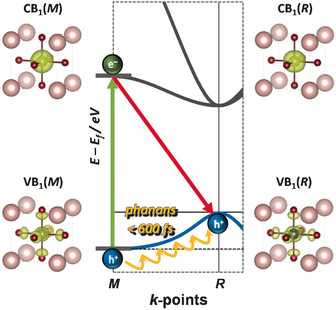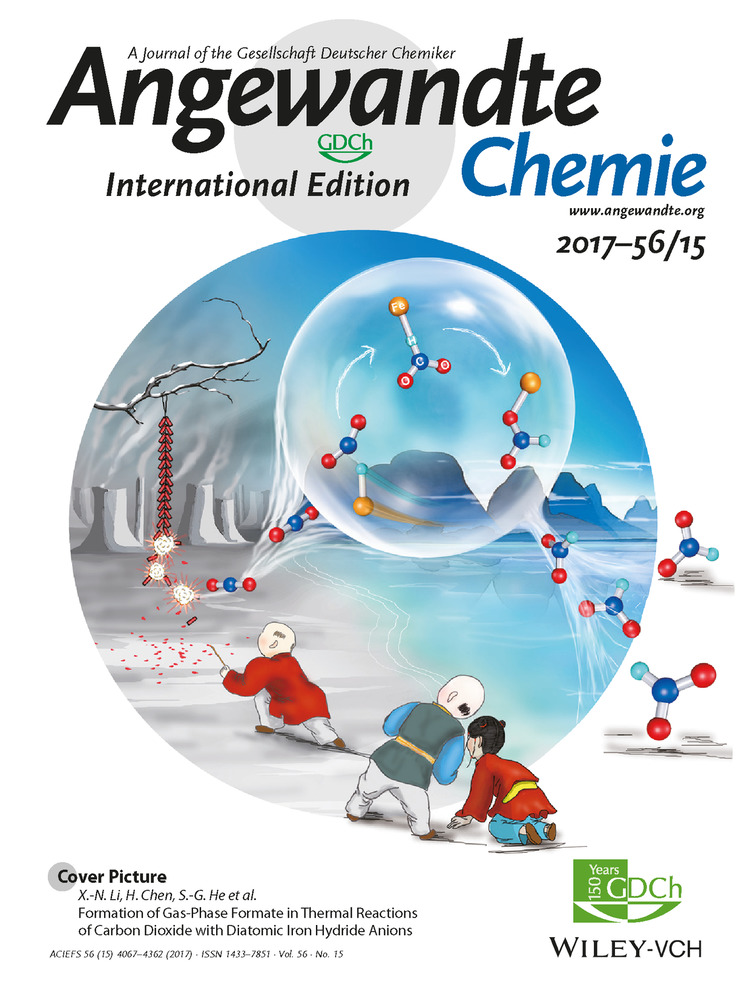Composition-Dependent Hot Carrier Relaxation Dynamics in Cesium Lead Halide (CsPbX3, X=Br and I) Perovskite Nanocrystals
Heejae Chung
Department of Chemistry, Yonsei University, 50 Yonsei-ro, Seodaemun-gu, Seoul, 03722 Republic of Korea
Search for more papers by this authorSeok Il Jung
Department of Chemistry, Yonsei University, 50 Yonsei-ro, Seodaemun-gu, Seoul, 03722 Republic of Korea
Search for more papers by this authorHyo Jin Kim
Department of Chemistry, Yonsei University, 50 Yonsei-ro, Seodaemun-gu, Seoul, 03722 Republic of Korea
Search for more papers by this authorWonhee Cha
Department of Chemistry, Yonsei University, 50 Yonsei-ro, Seodaemun-gu, Seoul, 03722 Republic of Korea
Search for more papers by this authorProf. Dr. Eunji Sim
Department of Chemistry, Yonsei University, 50 Yonsei-ro, Seodaemun-gu, Seoul, 03722 Republic of Korea
Search for more papers by this authorProf. Dr. Dongho Kim
Department of Chemistry, Yonsei University, 50 Yonsei-ro, Seodaemun-gu, Seoul, 03722 Republic of Korea
Search for more papers by this authorCorresponding Author
Dr. Weon-Kyu Koh
Device Laboratory, Samsung Advanced Institute of Technology, Suwon, Gyeonggi-do, 16676 Republic of Korea
Search for more papers by this authorCorresponding Author
Prof. Dr. Jiwon Kim
School of Integrated Technology and Underwood International College, Yonsei University, Incheon, 21983 Republic of Korea
Search for more papers by this authorHeejae Chung
Department of Chemistry, Yonsei University, 50 Yonsei-ro, Seodaemun-gu, Seoul, 03722 Republic of Korea
Search for more papers by this authorSeok Il Jung
Department of Chemistry, Yonsei University, 50 Yonsei-ro, Seodaemun-gu, Seoul, 03722 Republic of Korea
Search for more papers by this authorHyo Jin Kim
Department of Chemistry, Yonsei University, 50 Yonsei-ro, Seodaemun-gu, Seoul, 03722 Republic of Korea
Search for more papers by this authorWonhee Cha
Department of Chemistry, Yonsei University, 50 Yonsei-ro, Seodaemun-gu, Seoul, 03722 Republic of Korea
Search for more papers by this authorProf. Dr. Eunji Sim
Department of Chemistry, Yonsei University, 50 Yonsei-ro, Seodaemun-gu, Seoul, 03722 Republic of Korea
Search for more papers by this authorProf. Dr. Dongho Kim
Department of Chemistry, Yonsei University, 50 Yonsei-ro, Seodaemun-gu, Seoul, 03722 Republic of Korea
Search for more papers by this authorCorresponding Author
Dr. Weon-Kyu Koh
Device Laboratory, Samsung Advanced Institute of Technology, Suwon, Gyeonggi-do, 16676 Republic of Korea
Search for more papers by this authorCorresponding Author
Prof. Dr. Jiwon Kim
School of Integrated Technology and Underwood International College, Yonsei University, Incheon, 21983 Republic of Korea
Search for more papers by this authorGraphical Abstract
Significant dependence of the hot-carrier relaxation rate on the halide (Br, I, or their mixture) is mainly attributable to the density of states for holes in the valence band of CsPbX3 nanocrystals. The hot-carrier relaxation rate is observed to decrease from CsPbBr3 to CsPbI3 NC. VB=valence band, CB=conduction band.
Abstract
Cesium-based perovskite nanocrystals (NCs) have outstanding photophysical properties improving the performances of lighting devices. Fundamental studies on excitonic properties and hot-carrier dynamics in perovskite NCs further suggest that these materials show higher efficiencies compared to the bulk form of perovskites. However, the relaxation rates and pathways of hot-carriers are still being elucidated. By using ultrafast transient spectroscopy and calculating electronic band structures, we investigated the dependence of halide in Cs-based perovskite (CsPbX3 with X=Br, I, or their mixtures) NCs on the hot-carrier relaxation processes. All samples exhibit ultrafast (<0.6 ps) hot-carrier relaxation dynamics with following order: CsPbBr3 (310 fs)>CsPbBr1.5I1.5 (380 fs)>CsPbI3 NC (580 fs). These result accounts for a reduced light emission efficiency of CsPbI3 NC compared to CsPbBr3 NC.
Supporting Information
As a service to our authors and readers, this journal provides supporting information supplied by the authors. Such materials are peer reviewed and may be re-organized for online delivery, but are not copy-edited or typeset. Technical support issues arising from supporting information (other than missing files) should be addressed to the authors.
| Filename | Description |
|---|---|
| anie201611916-sup-0001-misc_information.pdf989.6 KB | Supplementary |
Please note: The publisher is not responsible for the content or functionality of any supporting information supplied by the authors. Any queries (other than missing content) should be directed to the corresponding author for the article.
References
- 1L. Protesescu, S. Yakunin, M. I. Bodnarchuk, F. Krieg, R. Caputo, C. H. Hendon, R. X. Yang, A. Walsh, M. V. Kovalenko, Nano Lett. 2015, 15, 3692–3696.
- 2G. Nedelcu, L. Protesescu, S. Yakunin, M. I. Bodnarchuk, M. J. Grotevent, M. V. Kovalenko, Nano Lett. 2015, 15, 5635–5640.
- 3N. S. Makarov, S. Guo, O. Isaienko, W. Liu, I. Robel, V. I. Klimov, Nano Lett. 2016, 16, 2349–2362.
- 4Y. Yang, D. P. Ostrowski, R. M. France, K. Zhu, J. van de Lagemaat, J. M. Luther, M. C. Beard, Nat. Photonics 2016, 10, 53–59.
- 5X. Y. Zhu, V. Podzorov, J. Phys. Chem. Lett. 2015, 6, 4758–4761.
- 6H. Kawai, G. Giorgi, A. Marini, K. Yamashita, Nano Lett. 2015, 15, 3103–3108.
- 7E. Conwell, High Field Transport in Semiconductors, Academic Press, New York, 1967.
- 8S. Prabhu, A. Vengurlekar, J. Shah, Phys. Rev. B 1995, 51, 14233.
- 9V. I. Klimov, P. H. Bolivar, H. Kurz, Phys. Rev. B 1995, 52, 4728.
- 10A. Kojima, K. Teshima, Y. Shirai, T. Miyasaka, J. Am. Chem. Soc. 2009, 131, 6050–6051.
- 11M. Liu, M. B. Johnston, H. J. Snaith, Nature 2013, 501, 395–398.
- 12J. Burschka, N. Pellet, S.-J. Moon, R. Humphry-Baker, P. Gao, M. K. Nazeeruddin, M. Gratzel, Nature 2013, 499, 316–319.
- 13N. J. Jeon, J. H. Noh, Y. C. Kim, W. S. Yang, S. Ryu, S. I. Seok, Nat. Mater. 2014, 13, 897–903.
- 14V. I. Klimov, D. W. McBranch, Phys. Rev. Lett. 1998, 80, 4028–4031.
- 15A. L. Efros, V. A. Kharchenko, M. Rosen, Solid State Commun. 1995, 93, 281–284.
- 16B. L. Wehrenberg, C. Wang, P. Guyot-Sionnest, J. Phys. Chem. B 2002, 106, 10634–10640.
- 17P. Guyot-Sionnest, M. Shim, C. Matranga, M. Hines, Phys. Rev. B 1999, 60, R 2181–R2184.
- 18R. D. Schaller, J. M. Pietryga, S. V. Goupalov, M. A. Petruska, S. A. Ivanov, V. I. Klimov, Phys. Rev. Lett. 2005, 95, 196401.
- 19M. de Jong, L. Seijo, A. Meijerink, F. T. Rabouw, Phys. Chem. Chem. Phys. 2015, 17, 16959–16969.
- 20T. Tachikawa, I. Karimata, Y. Kobori, J. Phys. Chem. Lett. 2015, 6, 3195–3201.
- 21D. Shi, V. Adinolfi, R. Comin, M. Yuan, E. Alarousu, A. Buin, Y. Chen, S. Hoogland, A. Rothenberger, K. Katsiev, Science 2015, 347, 519–522.
- 22L. C. Schmidt, A. Pertegás, S. González-Carrero, O. Malinkiewicz, S. Agouram, G. Mínguez Espallargas, H. J. Bolink, R. E. Galian, J. Pérez-Prieto, J. Am. Chem. Soc. 2014, 136, 850–853.
- 23L. Cademartiri, E. Montanari, G. Calestani, A. Migliori, A. Guagliardi, G. A. Ozin, J. Am. Chem. Soc. 2006, 128, 10337–10346.
- 24F. Brivio, K. T. Butler, A. Walsh, M. van Schilfgaarde, Phys. Rev. B 2014, 89, 155204.
- 25J. Even, L. Pedesseau, M. A. Dupertuis, J. M. Jancu, C. Katan, Phys. Rev. B 2012, 86, 205301.
- 26J. Even, L. Pedesseau, C. Katan, M. Kepenekian, J.-S. Lauret, D. Sapori, E. Deleporte, J. Phys. Chem. C 2015, 119, 10161–10177.
- 27H. Chung, H. Choi, D. Kim, S. Jeong, J. Kim, J. Phys. Chem. C 2015, 119, 7517–7524.
- 28V. I. Klimov, J. Phys. Chem. B 2000, 104, 6112–6123.
- 29T. Debnath, S. Maiti, P. Maity, H. N. Ghosh, J. Phys. Chem. Lett. 2015, 6, 3458–3465.
- 30V. I. Klimov, Annu. Rev. Phys. Chem. 2007, 58, 635–673.
- 31V. I. Klimov, S. Hunsche, H. Kurz, Phys. Rev. B 1994, 50, 8110–8113.
- 32D. Bozyigit, N. Yazdani, M. Yarema, O. Yarema, W. M. M. Lin, S. Volk, K. Vuttivorakulchai, M. Luisier, F. Juranyi, V. Wood, Nature 2016, 531, 618–622.
- 33K. Momma, F. Izumi, J. Appl. Crystallogr. 2011, 44, 1272–1276.
- 34J. Kim, S. C. Lee, S. H. Lee, K. H. Hong, J. Phys. Chem. C 2015, 119, 4627–4634.
- 35T. Ahmed, C. La-o-vorakiat, T. Salim, Y. M. Lam, E. E. M. Chia, J.-X. Zhu, EPL 2014, 108, 67015.
- 36A. M. A. Leguy, P. Azarhoosh, M. I. Alonso, M. Campoy-Quiles, O. J. Weber, J. Yao, D. Bryant, M. T. Weller, J. Nelson, A. Walsh, M. Schilfgaarde, P. R. F. Barnes, Nanoscale 2016, 8, 6317–6327.
- 37J. M. Frost, K. T. Butler, F. Brivio, C. H. Hendon, M. van Schilfgaarde, A. Walsh, Nano Lett. 2014, 14, 2584–2590.





